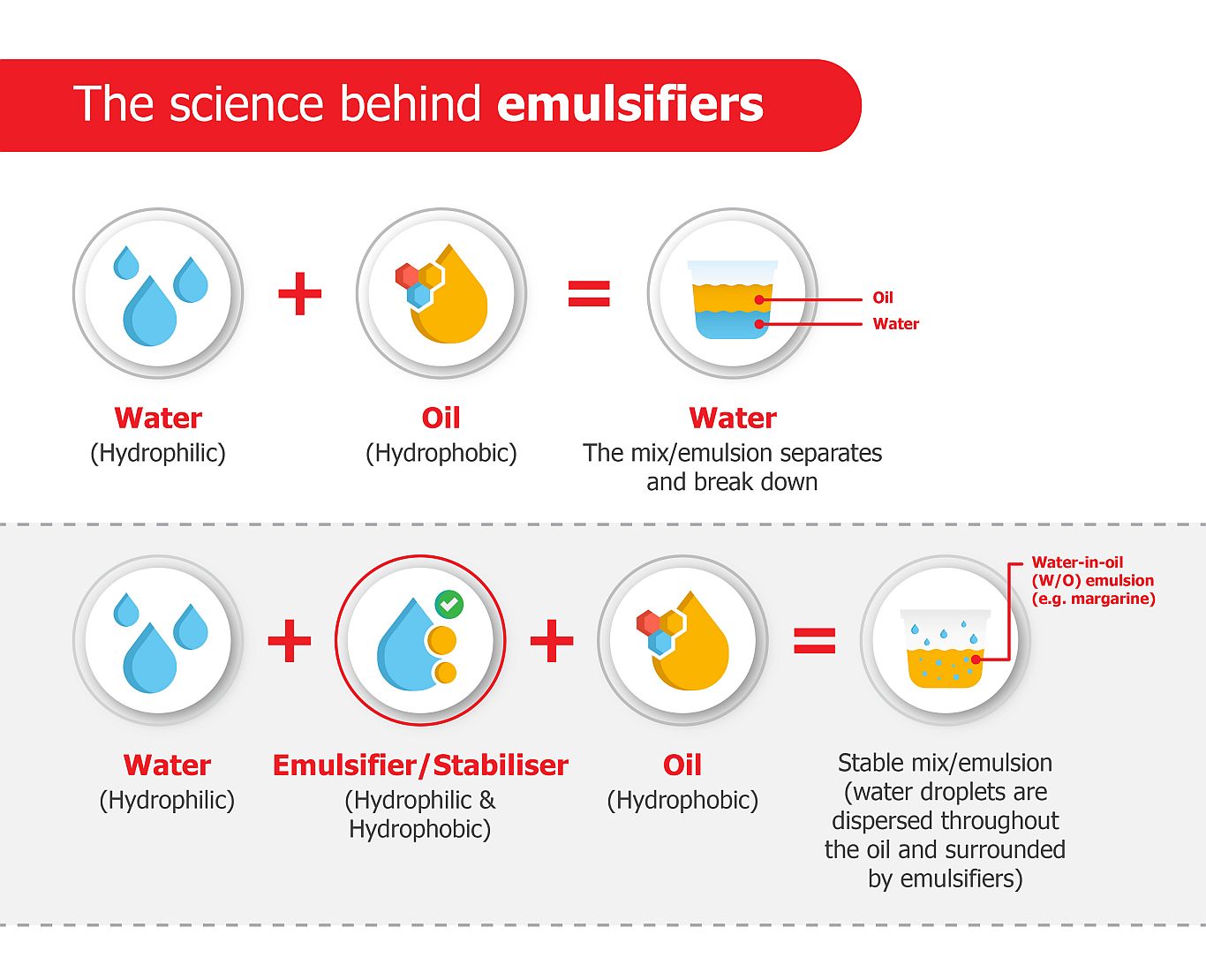The Development Over Time of Emulsifier In Food
Find out Exactly How an Emulsifier in Food Can Help Achieve Flawlessly Combined Recipes Every Time
Emulsifiers are vital active ingredients in the culinary globe, enabling the mixing of oil and water-based components. Their capacity to decrease surface area stress enables the creation of steady mixtures, boosting both structure and taste in various meals. Comprehending exactly how these compounds function can transform the method one comes close to food preparation. Several remain unaware of the different kinds of emulsifiers and their particular applications. Exploring this topic discloses important understandings for achieving culinary excellence.
What Are Emulsifiers and Just How Do They Work?
Emulsifiers play an important duty in the food industry by allowing the secure mixing of ingredients that usually do not integrate, such as oil and water. These materials have both hydrophilic (water-attracting) and hydrophobic (water-repelling) buildings, permitting them to communicate with both kinds of components. When an emulsifier is added to a blend, it decreases the surface area stress in between the oil and water, promoting the formation of small beads of one liquid dispersed within the other. This procedure produces a steady emulsion, stopping separation over time and improving structure and mouthfeel. Emulsifiers are essential in numerous foodstuff, from salad dressings to ice creams, making certain consistency and quality. They also add to the total sensory experience of food, influencing flavor release and visual allure. Recognizing just how emulsifiers work is important for food scientists and chefs alike, as they strive to develop balanced and satisfying culinary experiences.
Common Sorts Of Emulsifiers Utilized in Food Preparation
Numerous kinds of emulsifiers are made use of in cooking to accomplish wanted textures and stability in different food items. Typical emulsifiers consist of lecithin, which is normally found in egg yolks and soybeans, and is widely used in mayo and dressings. An additional widespread emulsifier is mustard, which contains compounds that help mix oil and water in sauces.
In addition, industrial emulsifiers such as mono- and diglycerides are commonly contributed to refined foods to improve their security and improve shelf life. Starch-based emulsifiers, originated from corn or potatoes, are additionally used in sauces and desserts for enlarging and structure. Ultimately, casein, a milk healthy protein, works as an emulsifying representative in milk items like cheese and lotion. Each of these emulsifiers plays a necessary role in making certain that ingredients mix effortlessly, providing the desired uniformity and flavor in culinary developments.
The Scientific research Behind Emulsification

The security of an emulsion relies on the balance in between the pressures acting on the dispersed beads. If the beads coalesce, the emulsion can break, leading to separation. Various aspects, such as temperature level, focus of the emulsifier, and the technique of blending, influence the success of emulsification. Comprehending this clinical foundation is essential for attaining constant results in culinary applications entailing solutions.
Tips for Using Emulsifiers in Your Recipes
When incorporating emulsifiers into dishes, cautious consideration of their residential properties and functionality can substantially improve the end product. Initially, one need to choose the appropriate emulsifier based upon the wanted structure and stability of the recipe. Emulsifier In Food. Usual choices consist of lecithin, egg, and mustard yolks, each offering distinct advantages
It's important to understand the next temperature at which the emulsifier operates best; for circumstances, some emulsifiers work successfully at room temperature level, while others need heat. Slowly including oil to the emulsifier while whisking can assist develop a secure emulsion.
In addition, the ratio of emulsifier to fluid is crucial; also little may cause separation, while way too much can develop an unwanted structure. Lastly, appropriate storage space conditions should be thought about, as some emulsified products might need refrigeration to keep stability and freshness. By following these tips, chefs can achieve regularly well-blended recipes.

Delicious Recipes Featuring Emulsifiers
While many cooks might not realize it, including emulsifiers into recipes can elevate recipes to brand-new heights of flavor and texture. A classic vinaigrette advantages significantly from the addition of mustard, which acts as an emulsifier, providing a smooth consistency that binds oil and vinegar perfectly. Homemade mayonnaise showcases the power of egg yolks, producing a creamy, elegant sauce perfect for salads and sandwiches. - Emulsifier In Food
In baking, emulsifiers like lecithin can assist accomplish a tender crumb in cakes and muffins, boosting moisture retention. An abundant delicious chocolate ganache, made with whipping cream and chocolate, can likewise incorporate an emulsifier to maintain a smooth coating. In addition, ice creams frequently use emulsifiers to stop and ensure a creamy appearance ice crystal development, causing a fascinating treat experience. By integrating these emulsifying agents, cooks can create dishes that thrill the taste and supply a gratifying mouthfeel.
Frequently Asked Concerns
Are Emulsifiers Safe for Individuals With Food Allergies?
Emulsifiers can be risk-free for individuals with food allergies, depending on the details emulsifier used. Nevertheless, cross-reactivity and specific level of sensitivities differ; consequently, speaking with a healthcare specialist is suggested to assure safety.
Can I Make My Very Own Emulsifier at Home?
Yes, people can create homemade emulsifiers making use of ingredients like egg yolks, mustard, or honey. These natural choices can efficiently blend oils and water-based components, using an easy remedy for different culinary applications.
Exactly How Do Emulsifiers Affect the Nutritional Worth of Food?
Emulsifiers can boost the dietary value of food by improving nutrient absorption and security. However, extreme usage might bring about negative results, potentially modifying food digestion processes and affecting why not look here intestine health in sensitive people.


Are There Any Kind Of Unfavorable Side Results of Consuming Emulsifiers?
Some researches suggest that consuming emulsifiers may result in stomach concerns or interrupt intestine microbiota balance. Further research is necessary to completely comprehend their lasting effects on wellness and prospective unfavorable side effects.
Can Emulsifiers Modification the Flavor of My Dishes?
Emulsifiers can discreetly alter the flavor account of dishes. By enhancing structure and mouthfeel, they may make tastes much more noticable from this source or well balanced, yet they usually do not convey solid preferences on their very own.
Emulsifiers play a necessary duty in the food sector by enabling the stable mixing of components that usually do not combine, such as oil and water. Various types of emulsifiers are made use of in cooking to attain wanted appearances and stability in different food items. Furthermore, commercial emulsifiers such as mono- and diglycerides are commonly added to refined foods to boost their stability and boost rack life. It's crucial to understand the temperature level at which the emulsifier operates finest; for circumstances, some emulsifiers function efficiently at space temperature, while others call for warm (Emulsifier In Food). Emulsifiers can be secure for individuals with food allergic reactions, depending on the particular emulsifier utilized